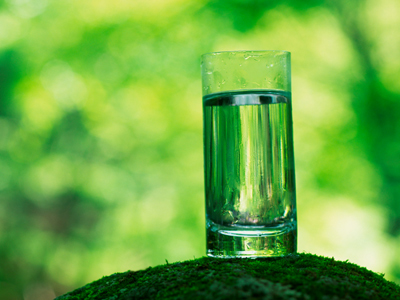The provision of clean water for us all is essential for mankind. In high school, Chemistry students will look at some of the methods of purifying
water, such as distillation, filtering and adding chlorine. This quiz will test you to see how well you understand these processes.
Water is absolutely essential to life on Earth. The human body is about 60% water and without water, it is only possible to survive for about 5 days (although some people have survived for a week). There are different opinions about how much water we should drink each day and it varies greatly from person to person. It is possible to drink too much water - this flushes sodium ions from the body and can lead to death. It is vital, however, that water for drinking is clean and free of harmful chemicals (e.g. heavy metals) and microbes. In developing countries, millions of people die from diseases like cholera and dysentry from drinking dirty water.
The simplest way of purifying water is by distillation. The water is heated and evaporates. The water vapor is condensed in some sort of condenser that allows it to be collected in a clean vessel. Any bacteria, viruses and microorganisms are destroyed by the heating process (provided that it is boiled or heated to at least 70oC) whilst the solids and dissolved minerals are left behind. For people who survive a ship or boat sinking, even though they are surrounded by water, purifying it is not easy. In many life rafts now, there is equipment for distilling life-saving pure water from seawater. Drinking seawater has the opposite effect to drinking too much water - the amount of minerals in your blood increases beyond a safe level and your brain and other organs start to malfunction.
The problem with distillation for purifying water is that it takes a lot of energy and only produces pure water slowly. Scaling this up to provide pure water for a whole community is therefore not usually practical. On a large scale filtering is the main method used. The dirty water is passed through a metal grid and several filter beds made from sand and gravel. This removes the largest particles of insoluble matter - leaves, twigs, stones, soil and so on. But this cannot remove the fine clay particles or the microbes. After the filter beds, the water is left in a settling tank where aluminum sulfate and lime are added. This causes the small particles to clump together (if you want a great phrase to use in your exams - this is called flocculating the colloids) and gravity does the rest - the large particles settle to the bottom of this tank. More filtering then takes place as the water is passed through a fine filter, such as carbon granules, in order to remove the last particles. After that, chlorine is added to kill any microbes.
In some places, fluoride ions are added to water as it is a chemical that is known to help form strong teeth and bones. This is controversial because there are some people who believe that flouridation can lead to staining of teeth, bone disese and pain and it also takes away personal choice. Some homes use their own systems for further purifying water from the tap. These contain silver nanoparticles, carbon and ion exchange resins. The silver kills any remaining microbes, the carbon absorbs chemicals like chlorine and the resins remove ions such as any heavy metals.








